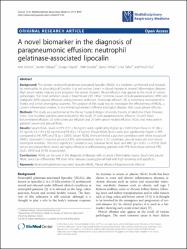| dc.contributor.author | Gümüş, Aziz | |
| dc.contributor.author | Özkaya, Şevket | |
| dc.contributor.author | Özyurt, Songül | |
| dc.contributor.author | Çınarka, Halit | |
| dc.contributor.author | Kırbaş, Aynur | |
| dc.contributor.author | Şahin, Ünal | |
| dc.contributor.author | Ece, Ferah | |
| dc.date.accessioned | 2020-12-19T20:15:48Z | |
| dc.date.available | 2020-12-19T20:15:48Z | |
| dc.date.issued | 2014 | |
| dc.identifier.citation | Gumus, A., Ozkaya, S., Ozyurt, S., Cinarka, H., Kirbas, A., Sahin., U., Ece, F., (2014). A novel biomarker in the diagnosis of parapneumonic effusion: neutrophil gelatinase-associated lipocalin. Multidisciplinary Respiratory Medicine, 9, article number 49. https://doi.org/10.1186/2049-6958-9-49 | |
| dc.identifier.issn | 1828-695X | |
| dc.identifier.uri | https://doi.org/10.1186/2049-6958-9-49 | |
| dc.identifier.uri | https://hdl.handle.net/11436/4037 | |
| dc.description.abstract | Background: The protein neutrophil gelatinase-associated lipocalin (NGAL) is a mediator synthesized and released by neutrophils. Its physiological function is as yet unclear. Levels in blood increase in several inflammatory diseases. High serum values indicate poor prognosis for several diseases. Pleural effusion may appear as the result of various pathologies. The most common cause is heart failure (HF). Other common causes include parapneumonic (PPE) and malignant (MPE) pleural effusions, and pulmonary embolism. Tubercular effusion (TE) is commonly encountered in Turkey and similar developing countries. The purpose of this study was to investigate the effectiveness of NGAL, a current inflammation marker, in discriminating between different etiological diseases that cause pleural effusion. Methods: The study was performed at the Recep Tayyip Erdoğan University Faculty of Medicine Chest Diseases Clinic. One hundred patients were included in the study, 25 with parapneumonic effusion, 25 with heart failure-related effusion, 25 with tubercular effusion and 25 with cancer-related effusion. NGAL was measured in patients' serum and pleural fluids. Results: Serum NGAL levels in PPE (171 ± 56 ng/ml) were significantly higher (p < 0.001) than those in HF (86 ± 31 ng/ml), CA (103 ±42 ng/ml) and TE (63 ± 19 ng/ml). Pleural NGAL levels were also significantly higher in PPE compared to HF, MPE and TE (p < 0.001). Serum NGAL levels exhibited a positive correlation with white blood cel (WBC), neutrophil, C-reactive protein (CRP), sedimentation, serum LDH, creatinine, pleural leukocyte and pleura neutrophil numbers. The most significant correlation was between NGAL level and WBC (p < 0.001, r= 0.579). Both serum and pleural NGAL levels are highly effective in differentiating patients with PPE from those without PPE (AUC: 0.910 and 0.790, respectively). Conclusions: NGAL can be used in the diagnosis of diseases with an acute inflammatory course. Serum and pleural NGAL levels can differentiate PPE from other diseases causing pleural fluid with high sensitivity and specificity. © 2014 Gümüs et al. | en_US |
| dc.language.iso | eng | en_US |
| dc.publisher | BioMed Central Ltd. | en_US |
| dc.rights | info:eu-repo/semantics/openAccess | en_US |
| dc.subject | Neutrophil gelatinase-associated lipocalin | en_US |
| dc.subject | NGAL | en_US |
| dc.subject | Parapneumonic effusion | en_US |
| dc.subject | Pleural effusion | en_US |
| dc.title | A novel biomarker in the diagnosis of parapneumonic effusion: neutrophil gelatinase-associated lipocalin | en_US |
| dc.type | article | en_US |
| dc.contributor.department | RTEÜ, Tıp Fakültesi, Dahili Tıp Bilimleri Bölümü | en_US |
| dc.contributor.institutionauthor | Gümüş, Aziz | |
| dc.contributor.institutionauthor | Özyurt, Songül | |
| dc.contributor.institutionauthor | Çınarka, Halit | |
| dc.contributor.institutionauthor | Kırbaş, Aynur | |
| dc.contributor.institutionauthor | Şahin, Ünal | |
| dc.identifier.doi | 10.1186/2049-6958-9-49 | |
| dc.identifier.volume | 9 | en_US |
| dc.identifier.issue | 1 | en_US |
| dc.relation.journal | Multidisciplinary Respiratory Medicine | en_US |
| dc.relation.publicationcategory | Makale - Uluslararası Hakemli Dergi - Kurum Öğretim Elemanı | en_US |


















